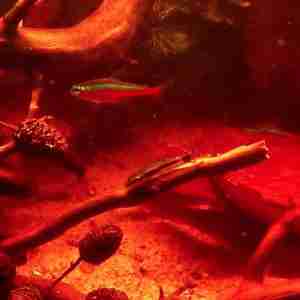Rio Orinoco Colombian Biotope
by Jeroen Vanhooren
 Biotope: Near the edges of a small Blackwater tributary of Rio Orinoco in Colombia
Biotope: Near the edges of a small Blackwater tributary of Rio Orinoco in Colombia
Dimensions: 70*50*35 (l*d*h)
Technical description
Lightning: 1 x Aquatlantis Easy Led 6800 K (28 W) – time controlled
Filter: internal sump with 2 sizes mechanical filtration media and a biological filtration medium. Peat substrate is added to the filter. Pump of 100 l/h circulates the water.
Substrate: white sand mostly covered by leaves and alder cones.
Water change: Automatic with 2 episodes of adding fresh water each day by a dripping system. Water temperature is controlled by a aquarium heater of 200 W.
Water temperature: This systems could be relatively high (26-29°C) due to high air temperature, but is somewhat tempered by the overhanging forest canopy.
Plants: Helanthium tenellum and Cabomba aquatica
Fish: Paracheirodon axelrodi and Otocinclus sp.
Biotope description: This aquarium simulates the bank of a small tributary of Rio Orinoco in Colombia. This little stream has a low flow, very low pH, negligible hardness in a relatively high temperature. The tea coloured water is the result of the decay of leaf litter which leaves tannins in the water.
 Paracheirodon axelrodi are among the most popular ornamental fish species. They live in a very broad area in different kinds of habitats (even in clear water). They live sympatric with lots of other popular fishes like hatchetfish, cichlids, other tetras and several kind of catfish. In this biotope aquarium I choose a nice group of Otocinclus sp.
Paracheirodon axelrodi are among the most popular ornamental fish species. They live in a very broad area in different kinds of habitats (even in clear water). They live sympatric with lots of other popular fishes like hatchetfish, cichlids, other tetras and several kind of catfish. In this biotope aquarium I choose a nice group of Otocinclus sp.
Behaviour and coloration of Paracheirodon axelrodi are completely different in these biotope tanks in comparison with community tanks. First of all the red stripe seems to disappear in the tea coloured water. I am not sure, but it seems to be a sort of camouflage color. Fishes seem to be less shy and seem to swim lower in the tank. The catching and trade of these fishes is an important economic activity in Colombia, Venezuela and Brazil. Although this lovely fish is still one of the most common in South America, deforestation, mining and other human activities pose a risk to local fish populations.
 Biotope One A Study of Flora and Fauna
Biotope One A Study of Flora and Fauna 


